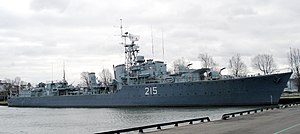HMCS Haida (G63)

HMCS Haida docked in Hamilton, Ontario.
|
|
| History | |
|---|---|
|
|
|
| Name: | Haida |
| Namesake: | Haida |
| Ordered: | 5 April 1940 |
| Builder: | Vickers-Armstrongs, Ltd., Newcastle-upon-Tyne |
| Yard number: | 41 |
| Laid down: | 29 September 1941 |
| Launched: | 25 August 1942 |
| Commissioned: | 30 August 1943 |
| Recommissioned: | 15 March 1952 |
| Decommissioned: | 11 October 1963 |
| Out of service: | 22 February 1964 |
| Identification: |
|
| Honours and awards: |
|
| Status: | Museum ship |
| Notes: | Now a museum ship and National Historic Site of Canada displayed at Hamilton, Ontario. Colours are gold and azure blue |
| Badge: | Or, a base barry wavy azure and argent, a thunderbird of the Haida tribe with wings displayed sable. |
| General characteristics | |
| Class and type: | Tribal-class destroyer |
| Displacement: |
|
| Length: | 377 ft (114.9 m) |
| Beam: | 37 ft 6 in (11.4 m) |
| Draught: | 13 ft (4.0 m) |
| Propulsion: | 2 shafts; 3-Admiralty 3 drum type boilers; 2-Parsons geared steam turbines, 44,000 shp (33,000 kW); |
| Speed: | 36.5 knots (67.6 km/h; 42.0 mph) (maximum), 32 knots (59 km/h; 37 mph) (service) |
| Complement: | 259 (14 officers, 245 ratings) |
| Sensors and processing systems: |
|
| Armament: |
|
| Official name | HMCS Haida National Historic Site of Canada |
| Designated | 1984 |
HMCS Haida is a Tribal-class destroyer that served in the Royal Canadian Navy (RCN) from 1943 to 1963, participating in World War II and the Korean War. Haida sank more enemy surface tonnage than any other Canadian warship. She is also the only surviving Tribal-class destroyer out of 27 vessels that were constructed between 1937 and 1945 for the Royal Navy, Royal Australian Navy, and the RCN.
The destroyer now serves as a museum ship on the waterfront of Hamilton, Ontario, and was designated a National Historic Site of Canada in 1984.
The Tribals were designed to fight heavily armed destroyers of other navies, such as the Japanese Fubuki class. Canada chose the design based on its armament, with the size and power of the Tribal class allowing them to act more like small cruisers than as fleet destroyers.Haida was among the first batch of Tribal-class destroyers ordered by the RCN in 1940–1941. They were ordered with modified ventilation and heating systems for North Atlantic winter service. Haida's design was modified after deficiencies were noted in the lead ship of the Canadian Tribals, HMCS Iroquois.
Haida, as one of the British-built Tribal-class destroyers, was 335 feet 6 inches (102.26 m) long between perpendiculars and 377 feet (115 m) long overall with a beam of 36 feet 6 inches (11.13 m) and a draught of 13 feet (4.0 m). As built, the destroyer displaced 1,927 long tons (1,958 t) standard and 2,745 long tons (2,789 t) at deep load.Haida had a complement of 14 officers and 245 ratings.
...
Wikipedia
